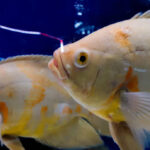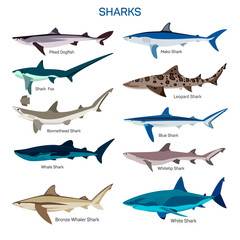Sharks are fascinating creatures that have captured human imagination for centuries. Understanding the it’s life cycle can offer insights into their behavior, conservation needs, and how they fit into the marine ecosystem. This comprehensive guide will take you through each stage of a shark’s life, from birth to adulthood, using simple language and accessible explanations.
Table of Contents
Introduction of Sharks
Sharks are a diverse group of fish known for their keen senses, powerful bodies, and predatory skills. There are over 500 species of sharks, ranging from the tiny dwarf lanternshark to the massive whale shark. Despite their fearsome reputation, sharks play a crucial role in maintaining the health of marine ecosystems.
Birth of Sharks
The life cycle of a shark begins with its birth. Depending on the species, sharks can be born in one of three ways: viperously, ovoviviparously, or viviparous.
Oviparous
Oviparous lay eggs, which are often encased in a protective shell. These eggs are commonly known as “mermaid’s purses.” Species such as the horn shark and the zebra shark are oviparous. The eggs are laid in secure locations on the ocean floor, where they incubate until the young sharks are ready to hatch. The incubation period can vary greatly, from a few months to over a year.
Ovoviviparous
Ovoviviparous sharks carry eggs inside their bodies. The eggs hatch internally, and the young sharks are born live. This method of reproduction offers greater protection to the developing embryos, as they are less vulnerable to predators. Examples of ovoviviparous sharks include the great white shark and the sand tiger shark.

Viviparous
Viviparous sharks give birth to live young, which have been nourished by a placenta-like organ. This is similar to the way mammals give birth. Species such as the hammerhead shark and the bull shark are viviparous. This method allows for the greatest survival rate of the young, as they receive direct nourishment from the mother and are born relatively developed.
Juvenile Stage
After birth, young sharks enter the juvenile stage. During this period, they must learn to hunt and avoid predators. Juvenile sharks often stay in shallow waters where they are less likely to encounter larger predators. Their diet typically consists of smaller fish and invertebrates. This stage is crucial for the development of their hunting skills and survival instincts.
Adolescent Stage
As they grow, they enter the adolescent stage. During this period, they continue to refine their hunting skills and increase in size. Adolescents begin to venture into deeper waters and may start to hunt larger prey. This stage can last several years, depending on the species.
Adult Stage
The adult stage is when sharks reach sexual maturity and can begin to reproduce. Adult sharks are typically at the top of the food chain, with few natural predators. Their diet includes a wide variety of prey, from fish and squid to marine mammals. Adult sharks play a vital role in maintaining the balance of marine ecosystems by controlling the populations of other species.
Mating and Reproduction
Mating and reproduction are critical components of the shark’s life cycle. Sharks have a variety of reproductive strategies, including internal fertilization. Males have claspers, which are modified pelvic fins used to transfer sperm to the female. The process can be quite aggressive, with males often biting females to hold them in place during mating.
They have long gestation periods, which can last from several months to over two years, depending on the species. This slow reproductive rate makes sharks particularly vulnerable to threats such as overfishing and habitat destruction.
Threats and Conservation
They face numerous threats that can disrupt their life cycle and impact their populations. Overfishing, habitat loss, and climate change are significant challenges. Shark finning, where sharks are caught, their fins removed, and the rest of the body discarded, is a particularly severe threat.
Conservation efforts are crucial to ensure the survival of shark species. These efforts include creating marine protected areas, enforcing fishing regulations, and raising public awareness about the importance of sharks to marine ecosystems. Supporting sustainable seafood choices and advocating for stronger protections can also make a difference.
Intricacies of Life Cycle
While the basic stages of a shark’s life cycle have been outlined, there are several fascinating details and nuances that add depth to our understanding of these incredible marine creatures.
Developmental Stages and Growth Rates
Sharks exhibit a wide range of developmental patterns and growth rates, which can be influenced by factors such as species, environmental conditions, and food availability. For instance, the growth rate of a great white species can be markedly different from that of a blue or a hammerhead . Some species grow rapidly, reaching maturity in just a few years, while others grow slowly, taking decades to reach adulthood.

Feeding Habits and Predatory Skills
During the juvenile stage, young sharks must quickly learn effective hunting strategies. Their diet primarily consists of small fish, crustaceans, and other marine organisms. Juvenile sharks often hunt in groups to increase their chances of a successful catch. As they grow, their diet diversifies, and their hunting techniques become more refined. This period is crucial for developing the agility and precision needed for capturing prey.
Survival Mechanisms
They have developed various survival mechanisms to protect themselves from predators and environmental challenges. Juvenile often have more pronounced camouflage patterns compared to adults, helping them blend into their surroundings and avoid detection by larger predators. Some species also exhibit unique behaviors, such as remaining in shallow waters or near reef structures, to increase their chances of survival during the vulnerable early stages of life.
Ecological Roles
They play a pivotal role in marine ecosystems by maintaining the balance of species populations. As apex predators, they help regulate the numbers of various marine creatures, ensuring that no single species dominates the ecosystem. This predatory behavior prevents the overpopulation of prey species, which can lead to detrimental effects on marine vegetation and other aquatic life forms. Understanding the life cycle of sharks highlights their ecological importance and the need for their conservation.
Reproductive Strategies and Challenges
Their reproduction is a complex process that varies significantly among species. The methods of reproduction—oviparous, ovoviviparous, and viviparous—each come with their own set of challenges and benefits. For example, oviparous species, which lay eggs, must find safe locations for their eggs to ensure they are not preyed upon. Ovoviviparous and viviparous species, which give birth to live young, invest significant energy in carrying and nourishing their offspring, but this increases the young sharks’ chances of survival.
Impacts of Human Activity
Human activities have a profound impact on shark populations. Overfishing, habitat destruction, and pollution are some of the major threats facing these marine predators. The practice of shark finning, in particular, has led to dramatic declines in certain shark species. Conservation efforts must address these issues to protect sharks and preserve their role in marine ecosystems.
Conservation Efforts
Effective shark conservation requires a multifaceted approach. Establishing marine protected areas can provide safe habitats where sharks can breed and grow without the threat of fishing. International cooperation is essential, as many shark species migrate across vast oceanic distances. Enforcing stricter regulations on fishing practices and banning harmful activities like shark finning are crucial steps. Additionally, public education campaigns can raise awareness about the importance of sharks and the need to protect them.

Technological Advances in Research
Advancements in technology have significantly enhanced our understanding of sharks. Satellite tagging and tracking allow researchers to monitor shark movements and behavior in real-time. Genetic studies provide insights into shark populations, their diversity, and their evolutionary history. These technological tools are invaluable for developing effective conservation strategies and ensuring the long-term survival of shark species.
The Future of Shark Conservation
The future of shark conservation hinges on global efforts to address the threats these creatures face. Continued research, combined with proactive conservation policies, can help mitigate the impact of human activities on shark populations. By fostering a greater appreciation for sharks and their ecological significance, we can inspire collective action to protect these magnificent animals for future generations.
The life cycle of sharks is a complex and fascinating journey that underscores their importance in marine ecosystems. From their developmental stages and survival mechanisms to their reproductive strategies and the threats they face, every aspect of their lives reveals the need for comprehensive conservation efforts. Understanding and protecting sharks is not just about preserving a species but about maintaining the health and balance of our oceans.
Conclusion
Understanding the shark’s life cycle is essential for appreciating these incredible creatures and recognizing their importance in the ocean. From birth through the juvenile, adolescent, and adult stages, each phase of a shark’s life is fascinating and vital to the health of marine environments. By learning about and supporting shark conservation efforts, we can help ensure that these remarkable animals continue to thrive in our oceans.




























































